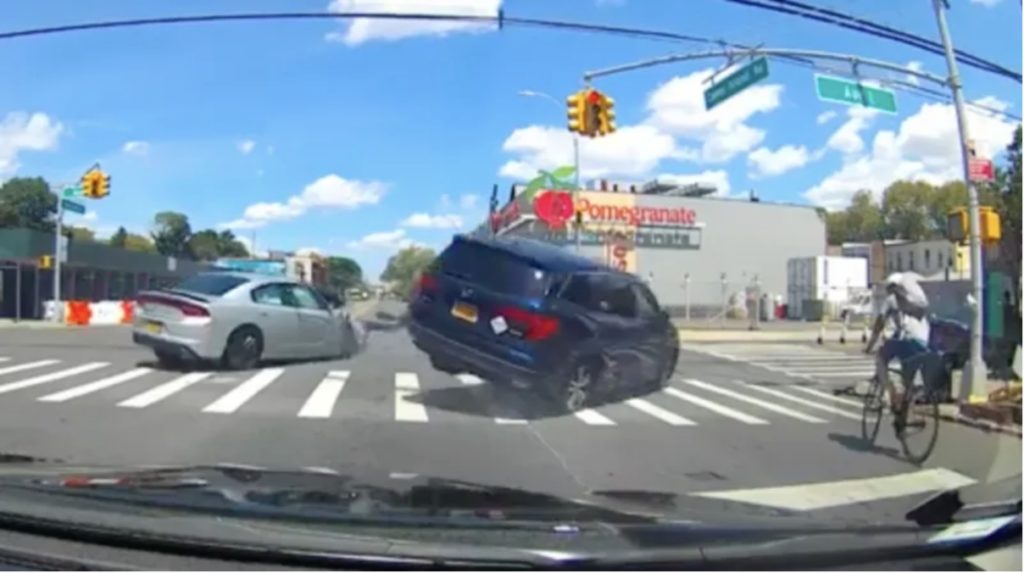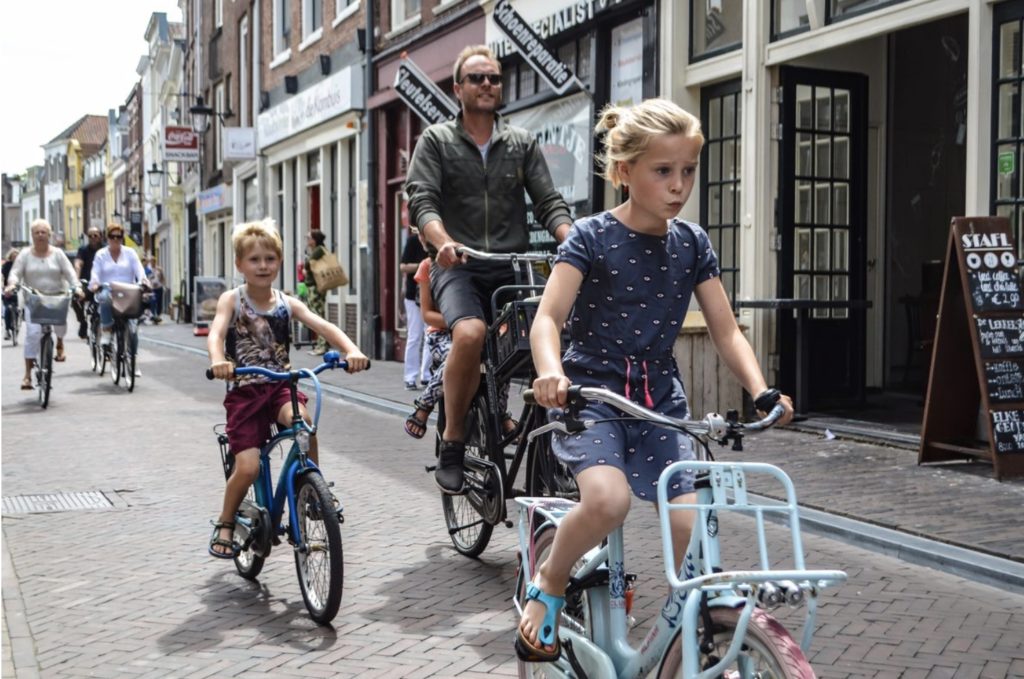Cyclists are dying in traffic, and it’s getting worse. And that raises the question—If we really wanted to protect cyclists from traffic fatalities, what would be most effective? Telling cyclists to protect themselves? Telling drivers to drive better? Or making it more difficult for careless and reckless drivers to kill in the first place?
If we require cyclists to “protect themselves” through mandatory helmet laws, that doesn’t address driver inattention. David Meek was wearing a helmet, and was lit up like a Christmas tree, and the driver who killed him “never saw him,” and Meek’s helmet did nothing to protect him from the injuries he sustained. Like Meek, I wear a helmet and ride with lights, but I’m under no illusion that they will protect me from an inattentive driver, or from the injuries I would sustain by being dragged under the tires of a truck.
If we require cyclists to “protect themselves” through mandatory helmet laws, that doesn’t address driver distraction. Milt Olin was wearing a helmet and riding in the bike lane, and the distracted driver who “never saw him” claimed that Olin had swerved into his path, when in fact the driver was distracted and drifted into the bike lane. And when the distracted driver slammed into Olin at 48 MPH, Olin’s helmet did nothing to protect him from the blunt force trauma that killed him.
If we require cyclists to protect themselves with helmets, that doesn’t address reckless driving. Jose Alzorriz was wearing his helmet when a speeding driver blew through a red light, causing the chain reaction collision that pinned Alzorriz under the van that hit him. And his helmet did nothing to protect him from the severe head injuries that claimed his life.
So why would the NTSB propose nationwide mandatory bicycle helmet laws if they don’t actually address the real problem? Because it’s easier than trying to understand the problem, and a LOT easier than doing something that would be effective. Require cyclists to wear helmets, and there, you can pretend you’ve fixed the problem.
But when we make bicycle helmets mandatory, we’re just shifting the responsibility for traffic safety from careless and dangerous drivers to their victims. That shift goes hand-in-hand with shifting the blame for car-on-bike crashes from drivers to their victims, and only ensures that the real problems will continue.
And if that isn’t galling enough, we already know what those problems are, and what needs to be done:
Inattentive driving
Careless drivers routinely say “I never saw” the cyclist. This is most likely true. After all, who but a sociopath would deliberately endanger a vulnerable road user? The problem is, when a driver says “I never saw the cyclist,” often what they are really saying is “I wasn’t paying attention.” So the driver who sideswiped David Meek said “I never saw him” as a way of explaining the crash that took Meek’s life, despite the fact that Meek was “lit up like a Christmas tree.”
Although inattentive drivers think of “I never saw” the cyclist as a rational explanation for their failure to see what is right in front of them, it’s really just an admission of negligence. Unless we’re talking about a ninja cyclist riding at night in all-black clothing and with no lights, the real reason the driver didn’t see the cyclist is because the driver wasn’t really watching the road.
And a helmet isn’t going to do anything to get them to pay attention.
Distracted Driving
Distracted driving is an enormous problem on American roads, and it’s only getting worse. Distracted driving has the same effect on a driver as a .08 blood alcohol level, and yet we treat distracted driving as a minor violation, right up until the point that a driver kills somebody. At that point, we change our minds and treat the fatal distraction as a major violation. And when we do that, we’re sending drivers a schizophrenic message.
Like inattentive drivers, distracted drivers miss what’s right in front of them, because they’re not paying attention to the road. Instead, they are distracting themselves with something other than driving. And often, that “something” they are distracting themselves with is an electronic device.
This is the difference between a distracted driver and an inattentive driver. The inattentive driver may just be daydreaming or preoccupied with other thoughts that takes their attention away from driving. The distracted driver intentionally takes their attention away from driving and directs it to something else in the car. But in both situations, the driver will fail to see what is right in front of them and would easily be seen if the driver was paying attention as the law requires. And in both situations, the driver will often explain their failure to see what they should have seen by saying “I never saw the cyclist.”
This is what a distracted Los Angeles County Sheriff’s Deputy said after he slammed into Milt Olin at 48 MPH. The Deputy, who had been texting his wife just before the crash, and who was typing on his mobile computer at the moment of impact, explained the fatal collision by saying “I never saw him,” further elaborating that Olin had suddenly swerved into the Deputy’s lane. But eyewitnesses told a very different story: The Deputy had drifted into the bike lane just before crashing into Olin.
“I never saw him” is also what the driver who killed Douglas Sager said, even though she had a 748 foot clear line of sight before she hit him. There’s only one way she couldn’t have seen him: She wasn’t paying attention. And the reason she wasn’t paying attention is because she was texting while driving. In fact, she was so distracted by texting that she drove the length of 2 ½ football fields without ever once noticing the cyclist in front of her. And in her mind, “I never saw him” explained everything.
But has anyone ever explained how mandatory bicycle helmet laws get drivers to hang up and drive?

Careless Driving
Careless driving means the driver was negligent in some way. It could mean that the driver had a legal duty to do something, but didn’t do it. It could also mean that the driver had a legal duty to not do something, but did it anyway.
For example, in California, drivers have a legal duty to safely merge into the bike lane before turning right. When a truck driver right-hooked Amelie Le Moullac in San Francisco, he had a legal duty to yield the right of way to Le Moullac and safely merge into the bike lane before turning, but failed to do so, and as a result of that failure, Le Moullac lost her life. At trial, the truck driver was found to be negligent, and the company whose truck he was driving was held liable for that negligence.
Reckless Driving
Reckless driving means the driver’s behavior was not just careless (that would be “ordinary negligence”) but exhibited extreme indifference or reckless disregard for the safety of others. A reckless driver knows or should know that his recklessness could lead to serious injury or death for others, but disregards that risk. And because reckless driving goes beyond ordinary negligence, it’s also a crime.
When a speeding driver blew through a red light at a Brooklyn intersection, he knew or should have known that there was a serious risk that somebody would be seriously injured or killed, but he did it anyway, and Jose Alzorriz lost his life as a result of that driver’s reckless behavior. The driver was subsequently arrested and charged with manslaughter.

Jose Alzorriz a moment before the crash
Sociopathic Driving
Most crashes aren’t intentional. Most drivers don’t intend to hurt somebody. But some drivers do want to hurt somebody, because they are sociopaths, and when they act on their intent to assault somebody, they’re committing a crime.
Every year, cyclists have been deliberately assaulted by drivers using their vehicles as weapons. Every cyclist has their own stories about the drivers who deliberately endangered their lives. Criminal assaults against cyclists are so endemic that many cyclists now ride with video cameras to record their assailants in the act and hopefully, bring them to justice. The news is replete with accounts of motorists who rolled coal on cyclists as they passed, threw items at cyclists as they passed, shot cyclists with pellet guns, shot cyclists with pepper spray, made punishment passes, threatened cyclists, and assaulted cyclists with their fists, and with their vehicles. And sometimes both. One enraged driver even shot a cyclist in the head because the cyclist was riding on the road. Fortunately the bullet lodged in the cyclist’s helmet, and not the cyclist’s head. Bullets are definitely not a bicycle helmet performance standard, so don’t try this at home.
What About Scofflaws?
Cyclists have a bad reputation as “scofflaws” in our society. But drivers are even greater scofflaws, breaking more laws more often. The truth is, cyclists are just people riding bikes, drivers are just people driving cars, and pedestrians are just people walking—and people break laws no matter how they’re getting around.
The difference between the three isn’t that people are “good” or “bad” based on whether they’re walking, riding, or driving. It’s that all people break some laws, but only one of those modes of transportation involves people operating dangerous machinery with a high potential for lethality if the operator is even momentarily careless. When a pedestrian or cyclist breaks the law, the greatest risk they pose is to themselves. When a driver breaks the law, they pose a risk to themselves and to others. But when a driver breaks the law and there are vulnerable road users nearby, the risk they pose is very high, and shifts entirely to the vulnerable road user. Two of the most common factors in car-on-bike crashes are unsafe speed and impaired driving/DUI, both of which are illegal and both of which have a very high potential for causing serious injuries and fatalities.
- Related Article: How To Avoid Car-On-Bike Accidents
- Related Article: Riding With Situational Awareness
- Related Article: Emergency Maneuvers Every Bicyclist Should Know
Most car-on-bike crashes are rooted in a traffic violation—the motorist, the cyclist, or both violated one or more laws, and a crash was the result. To learn more about the common types of car-on-bike crashes, and how to avoid them, two very good sources are Bicycle Accident Prevention and How To Not Get Hit By Cars.
Those are the problems cyclists face. But what are the solutions?
These are the real problems cyclists face on the road. And bicycle helmets do nothing to address these real problems. At best, in a low-speed crash, a bicycle helmet may mitigate some of the damage done by drivers. Maybe. Or maybe not.
But here’s the thing: in countries where cyclist safety is actually prioritized, we see large numbers of people riding bikes, and almost none of them wear helmets. The reason we see large numbers of people riding bikes in these countries is simple—their safety is prioritized, and it shows in both the cycling infrastructure, and in the underlying laws that protect cyclists and penalize careless driving. And because cyclist safety is prioritized, everybody “from 8 to 80” feels safe when they ride—so safe that they don’t need helmets, or reflective and hi-viz clothing, or video cameras to record what drivers did to them, or special classes to ride. They get on a bike, and they ride, and they get there safely. They don’t even think of themselves as “cyclists.” They’re just people riding a bike.

We know what the real problems are. And we know that mandatory bicycle helmet laws do nothing to address the real problems. But we also know what the real solutions are…




